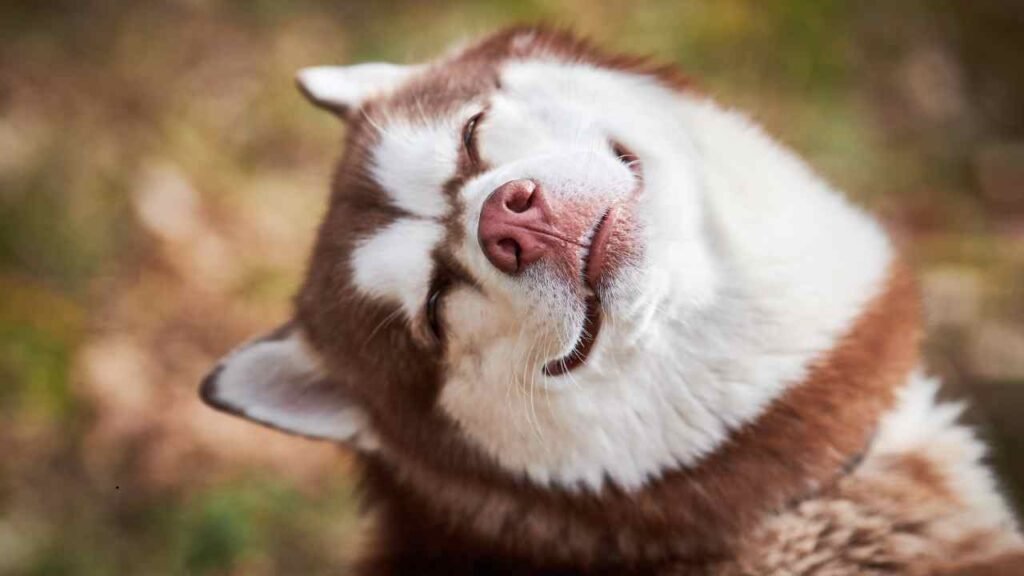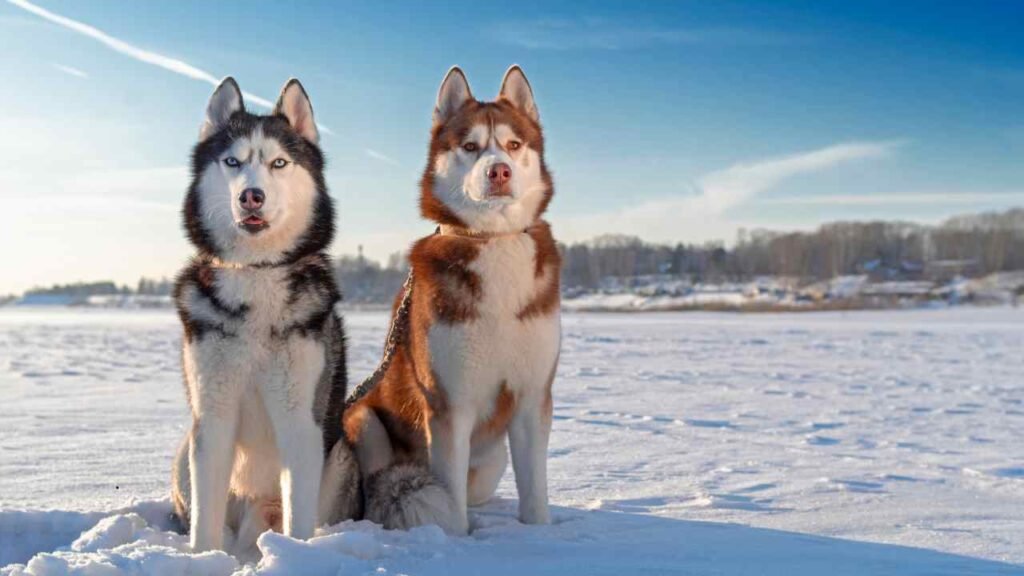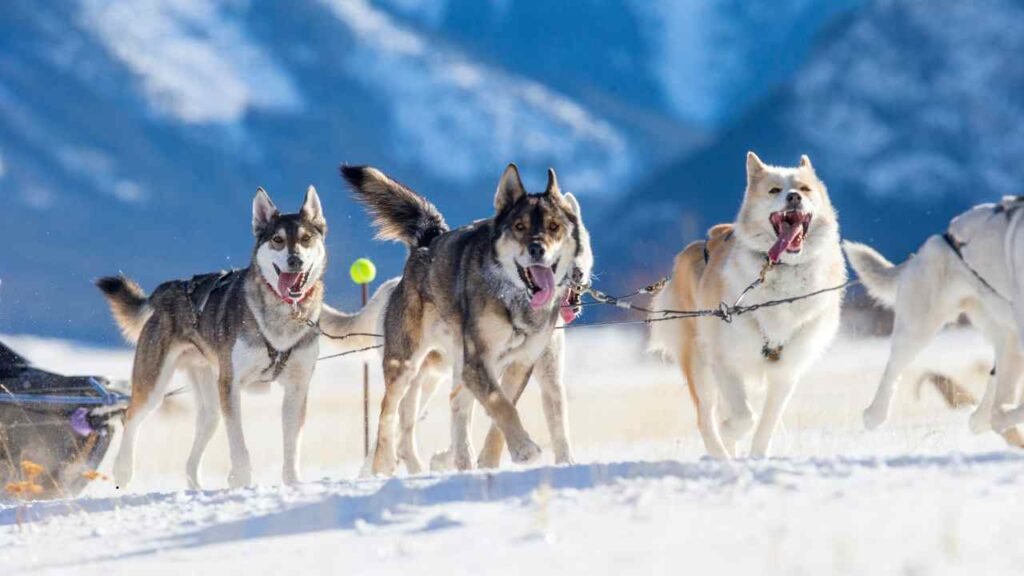Topics Covered in This Blog Post
With piercing blue eyes and a spirit as wild as the Arctic wind, the Siberian Husky is not just a dog—it’s a living symbol of endurance, freedom, and beauty. Originally bred by the Chukchi people of Siberia to pull sleds across vast, frozen landscapes, this breed combines stunning looks with an unbreakable will. Today, Huskies continue to capture hearts around the world—not only for their wolf-like appearance but also for their playful, loyal, and adventurous nature. Whether racing across snowy trails or curling up beside a fire, the Siberian Husky brings a unique energy into every home it enters.
Caring for a Siberian Husky

Siberian Huskies are energetic, intelligent, and independent dogs that require specific care to stay happy and healthy. Owning a Husky is a rewarding experience, but it also comes with responsibilities. Here’s what you need to know about taking care of this remarkable breed:
1. Exercise Needs
Huskies are born to run! Originally bred as sled dogs, they have high energy levels and need plenty of physical activity. Aim for at least 1 to 2 hours of exercise daily, which can include walks, runs, or playtime in a secure area. Without enough activity, they may become bored and destructive.
2. Grooming
Their double coat is designed to protect them in cold climates. Huskies shed heavily, especially during seasonal changes (known as “blowing their coat”). Brush them 2–3 times a week, and more often during shedding season, to keep their coat healthy and your home fur-free.
3. Diet and Nutrition
Feed your Husky a balanced, high-protein diet to support their active lifestyle. Avoid overfeeding—Huskies have efficient metabolisms and don’t usually eat as much as other dogs their size. Always provide fresh water and consult your vet for specific dietary recommendations.
4. Socialization and Training
Huskies are friendly but can be stubborn. Early socialization and consistent, positive reinforcement training are essential. They’re intelligent but independent thinkers, so patience is key. Crate training can also be useful for house training and providing a safe space.
5. Climate Considerations
While Huskies love cold weather, they can live in warmer climates too—with proper care. Avoid intense exercise during hot hours, provide shade and water, and never shave their coat, as it actually helps regulate body temperature.
6. Health Care
Routine vet checkups, vaccinations, and parasite prevention are crucial. Huskies are generally healthy but may be prone to certain conditions like hip dysplasia or eye issues (e.g., cataracts or progressive retinal atrophy).
Siberian Husky Health Issues

Siberian Huskies are generally a healthy and resilient breed, but like all dogs, they are prone to certain genetic and environmental health conditions. Responsible care, regular vet visits, and early detection can help manage or prevent most of these issues.
1. Hip Dysplasia
This is a common condition in many medium-to-large breeds. It occurs when the hip joint doesn’t fit properly into the hip socket, which can lead to arthritis or pain over time. Regular exercise, a healthy diet, and avoiding overexertion during puppyhood can reduce the risk.
2. Eye Conditions
Huskies are known for their striking eyes, but they are also more susceptible to several eye problems:
- Cataracts – Clouding of the eye lens, which can affect vision.
- Progressive Retinal Atrophy (PRA) – A degenerative disease that can lead to blindness.
- Corneal Dystrophy – A condition that affects the cornea and can cause cloudy eyes.
Regular eye checkups are important, especially as your Husky ages.
3. Hypothyroidism
This occurs when the thyroid gland doesn’t produce enough hormones, leading to weight gain, hair loss, and low energy levels. It’s manageable with medication once diagnosed.
4. Zinc Deficiency
Some Huskies may suffer from zinc-responsive dermatosis, a condition where the skin becomes crusty, especially around the mouth, eyes, and ears. A vet-prescribed zinc supplement usually helps manage it effectively.
5. Gastric Issues
Huskies can be prone to sensitive stomachs. They may develop food allergies or digestive issues if not given a proper diet. High-quality, easily digestible food is recommended.
6. Heat Sensitivity
Although not a disease, heat sensitivity is an important health consideration. Huskies can easily overheat in hot climates due to their thick double coat. Owners should avoid intense activity during hot weather and always provide access to cool, shaded areas.
What to Feed a Siberian Husky

Feeding a Siberian Husky isn’t just about filling a bowl—it’s about giving them the right fuel to match their high energy and unique metabolism. Huskies are known for eating less than other dogs their size, especially when they’re not exercising heavily. Choosing the right diet can help maintain their sleek body, thick coat, and overall health.
1. High-Quality Protein
Huskies are active dogs that need a protein-rich diet to support muscle development and energy. Look for foods where the first ingredient is real meat like chicken, turkey, beef, or fish.
2. Healthy Fats
Fats are a great energy source and help maintain a healthy coat. Ingredients like fish oil, flaxseed, and chicken fat provide omega-3 and omega-6 fatty acids, which are essential for skin and fur health.
3. Complex Carbohydrates
Unlike simple carbs, complex carbs provide steady energy. Ingredients like sweet potatoes, brown rice, oats, or barley are good options. Avoid fillers like corn, soy, or wheat which can be hard on their stomachs.
4. Fruits and Vegetables
These provide important vitamins, minerals, and fiber. Blueberries, carrots, spinach, and pumpkin are great additions to a Husky’s diet, whether in dry kibble or homemade meals.
5. Water
Huskies must always have access to fresh water, especially after exercise or in warmer climates. Their thick coat makes them prone to overheating, so hydration is key.
Feeding Tips
- Meal Size: Adult Huskies usually need 1.5 to 2.5 cups of high-quality dog food per day, divided into two meals. Amount may vary based on age, size, activity level, and metabolism.
- Avoid Overfeeding: Huskies are known to self-regulate their food intake. If they’re not very active, they might eat less.
- No Table Scraps: Human food, especially salty, fatty, or sugary items, can upset their stomach or lead to weight gain.
- Treats in Moderation: Healthy treats like dried meat or dental chews are fine, but they should make up no more than 10% of daily calorie intake.
🦴 Basic Feeding Guidelines for a Siberian Husky
🕑 Feeding Schedule
- Adult Huskies: 1–2 meals per day
- Puppies (up to 6 months): 3–4 meals per day, then taper to 2 meals
🍽️ Portion Size
- Depends on:
- Age
- Weight
- Activity level
- Type of food (kibble, raw, homemade)
- Average adult: 2–2.5 cups of high-quality kibble daily, split into 2 meals
🥩 Types of Food You Can Feed
1. Dry Kibble (Commercial Dog Food)
- Go for grain-free or high-protein formulas
- Look for named meat sources like “chicken” or “salmon” as the first ingredient
2. Raw Diet (BARF)
- Balanced with muscle meat, organ meat, bones, and veggies
- Popular with working or very active Huskies
- Consult a vet or canine nutritionist if doing this to avoid nutrient gaps
3. Home-Cooked Meals
- Allows full control over ingredients
- Must be balanced with protein, carbs, fat, fiber, and essential nutrients
⚠️ Foods to Avoid
- Chocolate, onions, grapes/raisins
- Cooked bones (they splinter)
- High-fat scraps (Huskies are prone to pancreatitis)
- Corn, soy, wheat (can cause allergies in some)
💧 Water Intake
- Always provide fresh, clean water
- Especially important after exercise or during warmer months
🧬 Husky Feeding Quirks
- Efficient eaters: Huskies require less food than similarly sized breeds
- Can be picky eaters – they might skip meals occasionally (this is normal unless it lasts more than a day or two)
- Tend to eat based on activity – more active = more appetite
🐾 Tips
- Keep a consistent feeding schedule
- Don’t free-feed (leave food out all day) – encourages picky behavior
- Monitor weight and body condition – Huskies should have a visible waist and feel of ribs without being bony
🧠 Siberian Husky Personality & Temperament
🐺 Core Traits
- Friendly & Social: Generally love people, including strangers
- High Energy: Bred to run long distances; needs LOTS of exercise
- Independent Thinkers: Smart but not always eager to please
- Vocal: Known for “talking,” howling, and dramatic whining
- Pack-Oriented: Thrive in families or multi-dog homes
- Curious & Mischievous: Love exploring, can be escape artists
🧬 Temperament
- Not aggressive but also not great guard dogs (they like everyone)
- Tend to be stubborn—they’ll weigh your commands before deciding to listen
- Can get bored easily, which leads to destructive behavior
- Often prey-driven (careful around cats or small animals unless raised together)
🐾 Training Tips for Siberian Huskies
1. Start Early
- Begin training and socialization as a puppy
- Introduce to different people, environments, noises, and animals
2. Positive Reinforcement
- Use treats, praise, and play to reward good behavior
- Avoid harsh corrections—Huskies will just shut down or ignore you
3. Stay Consistent
- Be firm but fair
- Don’t give mixed signals—Huskies will take a mile if you give an inch
4. Mental Stimulation is Key
- Puzzle toys, obedience training, scent games
- Boredom = chewed furniture or a dug-up yard
5. Exercise, Exercise, Exercise
- At least 1–2 hours of vigorous activity every day
- Running, hiking, agility, or even pulling carts/sleds
- A tired Husky is a well-behaved Husky
6. Crate Training
- Helps with house training and keeps them safe when unsupervised
- Huskies often try to escape when left alone—crate can help prevent this
7. Recall Training is a Challenge
- Huskies are known for poor off-leash recall due to their strong prey drive
- Use a long line and train in fenced areas
🚨 Common Husky Behaviors to Be Aware Of
| Behavior | Meaning | What to Do |
|---|---|---|
| Howling | Communicating or bored | Ensure enough exercise & interaction |
| Digging | Natural instinct, often to cool off or entertain | Provide a digging spot or distraction |
| Escaping | Curious and adventurous | Secure fences, use GPS collars |
| Chewing | Boredom or teething | Provide chew toys, rotate often |
❤️ Summary
Siberian Huskies are:
- Affectionate but independent
- Playful but strong-willed
- Athletic but escape-prone
They’re loyal companions when their needs are met, but they require an experienced or prepared owner who understands how to handle a smart, high-energy, free-spirited dog.
🧼 Siberian Husky Grooming Guide
🐕🦺 Coat Basics
- Double Coat:
- Topcoat: Straight guard hairs that repel dirt and moisture
- Undercoat: Soft, dense, and insulating—this is what sheds like crazy
- Sheds: All year, but “blows coat” heavily twice a year (spring & fall)
- Never shave a Husky: Their coat regulates temperature and protects from sunburn
🧹 Grooming Routine
1. 🪮 Brushing
| Frequency | Tools Needed | Notes |
|---|---|---|
| 2–3x per week (normal) | Slicker brush + undercoat rake | Prevents matting, removes loose fur |
| Daily (during shedding season) | Deshedding tool (like Furminator) | Helps manage coat blowing |
Tip: Always brush in the direction of hair growth and work in sections.
2. 🛁 Bathing
- Every 3–4 months (or when really dirty)
- Use a dog-specific, gentle shampoo
- Too much bathing strips natural oils and dries their skin
Tip: During coat-blow season, a warm bath + blow dry can help loosen dead undercoat (prepare for fur explosion).
3. ✂️ Nail Trimming
- Every 2–4 weeks
- Use clippers or a Dremel tool
- Watch for the quick (the pink part inside the nail) to avoid bleeding
Tip: If you can hear clicking on the floor, they’re too long.
4. 👂 Ear Cleaning
- Clean monthly or as needed
- Use vet-approved ear cleaner + cotton ball (never go deep)
- Watch for redness, odor, or excessive wax—signs of infection
5. 😬 Dental Care
- Brush 2–3 times per week with dog toothpaste
- Dental chews help but don’t replace brushing
6. 🧊 Paw Care
- Trim fur between paw pads if it gets long
- Check for cuts, ice buildup, or debris, especially after hikes or snowy walks
💡 Bonus Tips
- Grooming from puppyhood helps them tolerate handling
- Use grooming time to check for bumps, ticks, or skin issues
- A high-velocity dryer (used carefully) is great for blowing out undercoat
- Huskies are naturally clean dogs—they rarely smell bad or need frequent baths
✨ Grooming Schedule Snapshot
| Task | Frequency |
|---|---|
| Brushing | 2–3x/week (daily when shedding) |
| Bathing | Every 3–4 months |
| Nail Trimming | Every 2–4 weeks |
| Ear Cleaning | Monthly or as needed |
| Teeth Brushing | 2–3x/week |
| Paw Checks | Weekly |
🐾 Considerations for Pet Parents of Siberian Huskies
🏃♂️ 1. Energy Levels
- Huskies are extremely energetic and need 1–2 hours of exercise every day
- Not a great match for low-activity households
- Ideal for runners, hikers, or people who enjoy outdoor adventures
👉 If they don’t get enough exercise, they WILL invent their own fun—chewing, digging, escaping.
🧠 2. Mental Stimulation
- Smart, problem-solving dogs that get bored easily
- Need puzzle toys, training games, and social interaction to stay sane
- Bored Husky = destructive Husky
🧊 3. Climate Suitability
- Bred for cold weather—thrive in cooler climates
- Can live in warm places, but must have shade, water, and be walked in the cooler hours
- Never shave them thinking it’ll help—they need that coat to regulate heat
🧬 4. Prey Drive
- Strong instinct to chase small animals (squirrels, cats, rabbits)
- Early socialization helps, but off-leash in an open area is risky
- Recall is unreliable for most Huskies
🏠 5. Living Situation
- Not ideal for apartments unless you’re very active and committed
- Need a secure, fenced yard—they’re escape artists (diggers, jumpers, climbers)
- Crate training is often a must for safety when unsupervised
🧼 6. Shedding and Grooming
- Heavy shedders, especially twice a year when they “blow coat”
- Weekly brushing (daily during shedding seasons) is non-negotiable
- Not hypoallergenic
🐶 7. Social Personality
- Very friendly and not naturally aggressive
- Often love people and other dogs—may not be good guard dogs
- Can suffer from separation anxiety if left alone too long
🎓 8. Training Needs
- Very smart, but stubborn and independent
- Need patient, consistent, and positive training methods
- Best results come from early training and socialization
💸 9. Time and Financial Commitment
- Quality food, grooming tools, toys, vet care, and training can add up
- Huskies live ~12–15 years—this is a long-term investment
- Pet insurance might be a good idea, especially if they’re very active or escape-prone
❤️ 10. Emotional Readiness
- You need to be okay with chaos, fur on everything, and a little bit of sass
- Huskies are loving but not always cuddly; some are very independent
- Be prepared for a relationship that feels more like a wild roommate than a submissive pet
✅ Is a Husky Right for You?
Consider a Husky if:
- You’re active, outdoorsy, and love big personalities
- You’re ready to commit to daily mental & physical exercise
- You enjoy a challenge and aren’t easily frustrated
Maybe reconsider if:
- You want a low-maintenance or chill dog
- You live in a very hot or small space and can’t compensate with exercise
- You’re a first-time owner not ready for an intense breed
🐺 Siberian Husky FAQs
- Are Huskies good family dogs?
👉 Yes! They’re friendly and great with kids. - Can Huskies live in hot weather?
👉 Yes, but they need shade, water, and cool walks. - Do they get along with other pets?
👉 With dogs, yes. Small pets? Be careful. - Are they easy to train?
👉 Not really. They’re smart but very stubborn. - Do they shed a lot?
👉 A LOT. All year, and even more in spring/fall.
Explore More Breeds and Conduct Further Research
